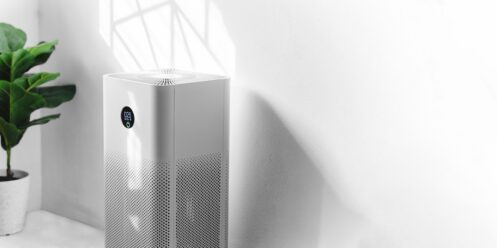
Humidifiers and dehumidifiers are appliances that help stabilize moisture levels within rooms. These appliances can help achieve ideal indoor relative humidity (RH). According to the Environmental Protection Agency (EPA), ideal indoor relative humidity falls between 30%-50%, and humidity levels should never exceed 60%. While the standard recommendation makes sense on paper, you may have additional questions based on the climate, the appliance model, and your household needs. A comparison between humidifiers and dehumidifiers can help you make an informed decision about improving the indoor air quality of your home.
What Is a Humidifier?
A humidifier is a device that adds moisture to the air by emitting water vapor or steam. Humidifiers may help alleviate problems associated with lower humidity levels, such as dry nasal passages or dry skin. Most humidifiers operate using a basic sensor mechanism. This sensor detects the humidity level in a room or enclosed space. The humidifier then switches on whenever humidity levels drop too low. Once it switches on, the device releases vapor or steam from its reservoir to raise humidity levels. Sizes of humidifiers include central humidifiers for the whole house, console humidifiers for specific rooms, and portable humidifiers that you can use while traveling. Types of humidifiers include whole-home humidifiers, evaporators, ultrasonic humidifiers, impellers, and steam vaporizers.
Whole-Home Humidifiers
Whole-home humidifiers are central humidifiers hardwired directly into the HVAC system. These humidifiers provide moisture to the entire house at an adjustable rate. Whole-home systems can include bypass humidifiers that connect to your ducts or power humidifiers fitted with fans that help generate greater humidity. While this type of system represents more of an investment than other varieties, it can also help ensure consistent humidity levels and air quality throughout the home. Other benefits include the reduction of static electricity and dust levels indoors. If your household’s occupants include vulnerable populations, like infants or the elderly, whole-home humidifiers may help alleviate breathing problems or dry skin. They are also popular since there is no risk of direct contact with the appliance itself.
Evaporators
If you have ever noticed that the water level in a covered glass lowers or evaporates after a certain period, it is easy to see how evaporator humidifiers work in the same way. This humidifier cools air by drawing water from a reservoir and blowing the moisture through a wick, filter, or belt. Fans propel this appliance and disperse cool mist into the air using a single-unit system.
Ultrasonic Humidifiers
An ultrasonic humidifier consists of a diaphragm or disk immersed in water. The disc vibrates at an ultrasonic frequency outside of the range of human hearing. This vibration creates water droplets that the device can expel as mist, steam, or fog to increase indoor humidity. Ultrasonic humidifiers tend to be small and compact, making them suitable for limited space areas. And because ultrasonic humidifiers use vibration instead of a heating source, they are also popular in children’s rooms.
Impellers
Impeller humidifiers use rotating discs with comb-like fins that break water down into tiny droplets. The droplets then pass through a mesh filter, leaving the device as a cool mist that increases the humidity of your room. Impellers are most popular for use in single rooms.
Steam Vaporizers
Steam vaporizers use a power source to heat water in a reservoir. Once the water is boiling, the warm mist exits the device in the form of steam. Some steam vaporizers also allow you to add inhalants or essential oils for more comfortable breathing. But because they contain hot water, these vaporizers are not popular among households that have children. Homeowners who have children tend to choose whole-home humidifiers instead.
What Is a Dehumidifier?
A dehumidifier is a device that pulls excess moisture from the air. The device typically works by extracting water from air that flows through the unit. Most dehumidifiers use a refrigerator-based or a heater-based system along with a coil to remove moisture from the air. A fan or motor blows the air over a coil that causes the moisture to condense into vapor and collect into a reservoir or tray. The result is dry air that flows back into the room. Removing excess moisture from the air is an important way to stop the growth of mold, mildew, bacteria, dust mites, and other allergens. Types of dehumidifiers include whole-home dehumidifiers, refrigerated coil dehumidifiers, desiccants, electronic dehumidifiers, ionic membrane dehumidifiers, and makeshift dehumidifiers.
Whole-Home Dehumidifiers
Whole-home dehumidifiers connect directly into the HVAC system. Using the ductwork, this type of humidifier helps remove moisture from all rooms in the home at a steady rate. Whole-home dehumidifiers are popular choices for homes in high-humidity regions as well as older homes.
Refrigerated Coil Dehumidifiers
Refrigerated coil dehumidifiers are also known as mechanical or compressor dehumidifiers. These appliances have a built-in compressor, and they operate using a mechanism similar to your refrigerator. In a refrigerated coil dehumidifier, a small fan pulls the moist air over the coil. Refrigerant in the coil causes the moisture in the air to condense. The condensation then drips from the coil into a reservoir or tray.
Desiccant Dehumidifiers
The word desiccant means “drying agent.” Desiccant dehumidifiers use chemical substances to absorb moisture from the air. The substances are usually hydrophilic materials, such as silica gel. When a silica-coated wheel or belt rotates through the system, it helps dry out the surrounding air. Desiccant dehumidifiers work best under conditions of low temperature and extremely high humidity. They are popular during the winter and for industrial purposes.
Electronic Dehumidifiers
Electronic dehumidifiers often rely on heat pumps, fans, and exchange coils to pull in moist air. The moist air then passes over heat-exchange coils, causing the moisture to condense and collect into a reservoir or tray. Dry air then circulates back into your room. Electronic dehumidifiers are popular for enclosed spaces or small rooms.
Dehumidifying Ventilators
Dehumidifying ventilators draw in humid air and then use an exhaust fan to expel the moisture outside. These devices are useful for crawlspaces, basements, and attics. Compact in size, they function much like other window units.
Ionic Membrane Dehumidifiers
Ionic dehumidifiers help remove water from the air at a molecular level. This type of dehumidifier has traditional applications in chemical engineering, water filtering, and the fuel industry. However, homeowners may also find devices with ionic membrane filters by exploring options with an HVAC professional.
Why Is It Important to Maintain the Right Humidity Levels?
Indoor humidity levels that reach either extreme can become a source of great discomfort for all occupants of the home. Even if you set your thermostat at the ideal room temperature, you can still feel uncomfortable if humidity levels are too high or too low. Specifically, high humidity levels can make the air feel overly warm and smothering during hot weather, and low humidity levels can cause the air to feel even drier during cold weather. In addition, both high and low humidity levels can cause dehydration since these conditions disrupt natural sweating. Since sweating is one of the body’s primary cooling and regulating mechanisms, it is important to keep humidity as stable as possible.
Humidity also has an environmental impact as well. High humidity levels create the perfect breeding environment for mold, mildew, algae, and bacteria. Household pests like termites and carpenter ants also thrive in humid environments. On the other hand, low humidity can cause wood furniture and floors to experience dry air damage. Low humidity may also increase the likelihood of respiratory illness since some viruses thrive in dry environments. When moisture levels are insufficient, viral particles have an easier time settling in airway receptor sites, leading to a greater chance of infection.
What Signs Indicate the Need for a Humidifier or Dehumidifier?
Humidifiers
You may need a professional to install a humidifier if your indoor air becomes too dry. Signs of dry air include the buildup of static electricity due to low humidity. This can disrupt the proper performance of your electronics. Household occupants may experience dry skin, lips, or nasal passages. Individuals with eczema and dermatitis may find that these conditions worsen if indoor humidity is too low. In fact, the American Academy of Dermatology (AAD) recommends that people with these skin conditions install a humidifier at least during the winter. Other signs that you may need a humidifier include dry eyes or sore throat. Even books or papers within the home can become brittle if the air is too dry.
Dehumidifiers
Signs you need a dehumidifier include condensation on windows and furniture as well as the accumulation of mold, mildew, or dust mites in rooms. These occurrences indicate high levels of moisture in the air. You may also notice rotten or musty smells due to mold or the growth of other organisms. High humidity can increase the staying power of allergens, like pollen or dust particles, resulting in respiratory irritations. When moisture is too high, you may notice that dry kitchen goods become stale faster and even clothes take longer to dry.
Should I Use a Humidifier or Dehumidifier?
The optimal indoor humidity level falls between 30%-50%. An HVAC technician can use a professional hygrometer to measure the humidity within a particular space to determine whether you should choose a humidifier or dehumidifier. Indoor humidity that falls below 30% can require a humidifier, and levels above 50% may require a dehumidifier. In addition, seasons can also help determine humidifier or dehumidifier use. Homeowners often use humidifiers in the wintertime to combat the dryness of winter air. Humidifiers help saturate winter air with water that traps heat, creating a blanket effect that helps you feel warmer. Likewise, homeowners may use dehumidifiers during the spring and summer to combat seasonal allergens, like pollen, and reduce the sticky or stale feeling that can occur when indoor humidity is too high.
Contact Us Today
When used correctly, humidifiers and dehumidifiers can improve the indoor air quality of your home. Beltway Air Conditioning & Heating provides whole-home installation for households in Hanover and the surrounding areas. We can help you select the right device, and we offer professional installation, replacement, or maintenance of humidifier or dehumidifier systems. Contact Beltway Air Conditioning & Heating today to create the perfect indoor environment for the home.


